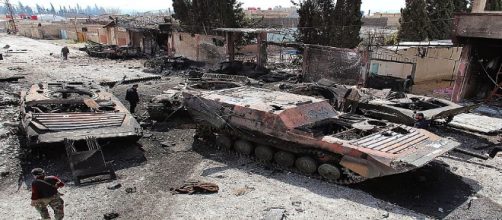Following the Syrian airstrikes, there has been very little in the news about what was hit and what has happened. The fallout from the strikes will no doubt be felt by the people of Damascus. There is chatter however, coming from the region that ISIL are making moves under the distraction of the missile strikes and that it wasn’t supposed chemical weapons sites that were hit.
Furthermore, there have been claims that 71 of the 100 missiles fired were intercepted by the Syrian Arab Army (SAA) defence forces and that the decisive and accurate attack was much more widespread than initially suggested by the UK, US and French governments.
Coalition airstrikes fallout
Sources from within Damascus have claimed that Mazeh airport, Al Dumair airport, Barzeh and Joumraya scientific research center and several military bases were hit by the strikes.
This suggests that the targets by the UK/US/French forces were designed to be more widespread than they suggested to the public when the attack was announced, it also suggests that they are attempting to cause widespread disruption to the Syrian forces to influence the civil war that erupted in 2011.
On the back of the attacks by the UK/US/French coalition, ISIL launched an offensive into the southern part of Damascus. Taking advantage of the Syrian army’s distraction. According to a military source, who told AMN News, the terrorist organisation launched an offensive by storming the Syrian Army’s positions within the Al-Qadam District. No gains have been reported and it is highly unlikely to succeed as the SAA recently moved a large proportion of the forces into the area in preparation for a full assault on the terrorist organisation.
It has also been confirmed that East Ghouta is now under control of the SAA after the last militant convoy leaves the area.
21st Century Wire and Syrian field reporter, Vanessa Beeley, underlines that if you map the timeline of the chemical weapons attacks in Syria, they occur whenever the SAA are close to liberating an area from the rebel forces. Every time the SAA have made significant gains and pushed back the rebels, a chemical weapons attack occurred which makes it easier for western powers to get involved and keep the war ongoing. Furthermore, Eastern Ghouta is an important stronghold for Israel in their desire to suppress Iran – who are allies of Assad – that would also potentially cripple Syrian air defences.
The Syrian turmoil
The region of Syria has been in relative turmoil for a while now and it is intrinsically linked with decisions that were made over a century ago on the eve of The Great War. The consequences of these have caused successive ripple effects within the region and whenever there is a chance of relative stability, the western powers often find a reason to use military action. It is difficult to judge for certain whether Assad has been responsible in the past but he commands a large support from the population and in 2014 won around 80 percent of the vote in an election which saw a turnout of around 70 percent. Furthermore,
The OPCW stated - “The Fact-Finding Mission (FFM) team of the Organisation for the Prohibition of Chemical Weapons (OPCW) will continue its deployment to the Syrian Arab Republic to establish facts around the allegations of chemical weapons use in Douma.” The team who are carrying out the inspection were planning to arrive on the 14th April, irrespective of the airstrikes the day before.
Furthermore, it is reported that the OPCW team were denied access by Syria and Russia, however, this is untrue, it was the UNSC who originally blocked the OPCW team because apparently, they ‘couldn’t guarantee their safety’. The team sent by the OPCW did arrive in Syria on the 14th April to begin their research.
What hasn’t been reported as much as yet is that the Independent’s Middle-East correspondent was the first western journalist to make it to the area in Douma which the alleged chemical attack took place. His report from the region states that there is no evidence of a chemical attack. These are testimonies from local doctors who would’ve been at the scene. One stated, “Then someone at the door, a ‘White Helmet’, shouted ‘Gas!”, and a panic began.
People started throwing water over each other. Yes, the video was filmed here, it is genuine, but what you see are people suffering from hypoxia – not gas poisoning.”
Finally, The Tomahawk missile used in the strike is made by Raytheon (rtn, +1.41%), whose stock opened 2.5% higher Friday, adding more than $1 billion to the defence contractor’s market capitalisation. The only people to have directly profited from these strikes are the wealthy elite who control wars for their gain, however, I will say that this is just a happy consequence for those as there is more at play than just immediate profit.

